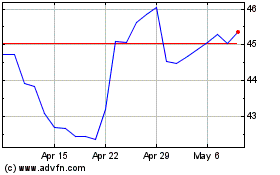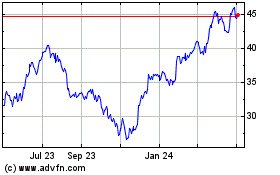GM Sees Brighter Profit Outlook as It Fends Off Computer-Chip Crunch -- 2nd Update
June 03 2021 - 4:20PM
Dow Jones News
By Mike Colias
General Motors Co. expects profits to be better in the first
half of the year than it previously projected, citing steps it is
taking to blunt the impact of the computer-chip shortage that has
hampered global vehicle production for months.
The auto maker said that in recent weeks it boosted vehicle
deliveries to dealerships by starting to release tens of thousands
of trucks that had been parked awaiting parts. It is racing to
restock record-low vehicle inventories at dealerships to satisfy
surging demand from U.S. car shoppers, who are turning out in big
numbers as pandemic restrictions recede.
GM on Thursday didn't provide specific numbers but said it
expects pretax profit for the first half of the year to be
significantly better than guidance it issued on May 5. The company
also said the disruption from the chip shortage will continue.
"I don't think we necessarily like updating guidance a month
after we just issued it," GM finance chief Paul Jacobson said
during a virtual Credit Suisse investor conference. "But that shows
you how fluid and volatile the situation has been."
GM shares advanced about 6% in afternoon trading Thursday to
$63.15, an all-time high since shares began trading publicly in
2010, a year after the auto maker's bankruptcy.
Mr. Jacobson said GM was able to pull some semiconductor
deliveries into the second quarter to help lift production and ship
vehicles that had been waylaid in parking lots nearby its U.S.
factories. He said GM initially had expected to deliver those
vehicles in the third quarter, which means the company now will be
able to book that revenue in the second quarter.
GM said in a statement it is optimistic it can make up ground in
the second half of the year and continues to prioritize production
of large pickup trucks and sport-utility vehicles, its biggest
money makers.
The revised outlook from the nation's largest auto maker by
sales is a welcome sign for an industry that has been coping with
decades-low inventory levels because of the chip shortage, just as
vehicle sales hit a near-record pace.
Car makers are trying to secure more chips and fill their
pipelines to U.S. dealerships to satiate strong demand, stoked by
stimulus money, continued low interest rates and pent-up demand
from the pandemic, analysts and dealers say.
Through mid-spring, the chip shortage had decimated vehicle
inventories, but dealers were able to maintain the near-record
pace. Tight supplies led to strong pricing, helping many car
companies and dealer groups post record profits.
But the pace of sales cooled a bit in May, a sign that the lack
of selection on dealership lots has begun to curb sales, analysts
and dealers said.
"We are clearly starting to see the impact of the supply
situation on end demand," RBC Capital analyst Joseph Spak said in
an investor note Wednesday.
U.S. vehicle sales in May fell to an average annualized selling
rate of around 17 million vehicles, down from a pace of about 18.8
million in April, according to research firm Wards
Intelligence.
GM's brighter profit outlook came on the same day rival Ford
Motor Co. released muted U.S. sales results for May, revealing the
toll the chip shortage has taken on its vehicle inventories.
Ford's May sales rose 4% from a year earlier, when Covid-19
quarantines sharply reduced U.S. car sales. That lagged behind the
industry's 42% increase for May and trailed GM's 37% increase and
Stellantis AG's 34% increase, according to data from research firm
Motor Intelligence, cited in a Credit Suisse note. GM and
Stellantis don't report monthly sales.
Ford reduced output at each of its two F-150 factories, in
Michigan and Kansas City, Mo., for weeks this spring due to the
chip shortage. GM, meanwhile, has been able to avoid down-time at
its plants that produce large pickups and SUVs. Ford said May sales
of F-Series pickup trucks fell 29% from a year earlier.
Ford shares rose about 7% in afternoon trading Thursday to their
highest level since 2015.
Last month, GM posted near-record pretax profit for the first
quarter of $4.4 billion but signaled the disruption from the chip
drought would sap second-quarter results. It also issued first-half
pretax-profit guidance of $5.5 billion, implying profit would fall
to around $1.1 billion for the April-to-June period.
The company on Thursday said only that first-half performance
would be significantly better than its previous $5.5 billion
forecast, but didn't provide numbers. It said it is optimistic
about the full year, which it previously said would deliver $10
billion to $11 billion in pretax profit.
GM previously said the chip shortage would shave $1.5 billion to
$2 billion from its bottom line this year.
Write to Mike Colias at Mike.Colias@wsj.com
(END) Dow Jones Newswires
June 03, 2021 16:16 ET (20:16 GMT)
Copyright (c) 2021 Dow Jones & Company, Inc.
General Motors (NYSE:GM)
Historical Stock Chart
From Aug 2024 to Sep 2024

General Motors (NYSE:GM)
Historical Stock Chart
From Sep 2023 to Sep 2024
